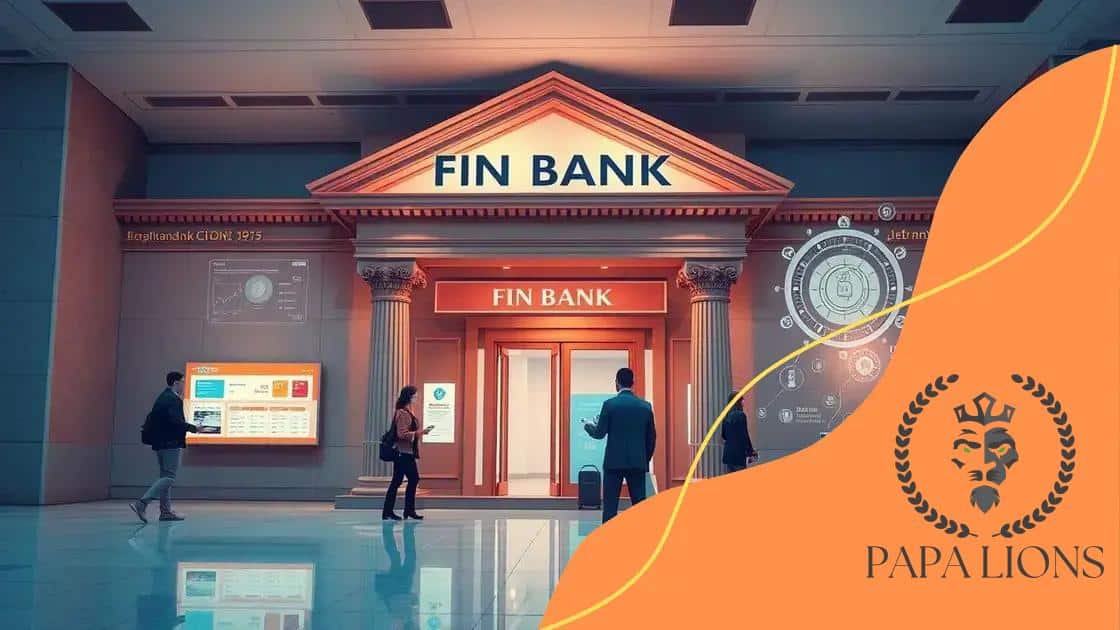Fintech disruption in payment systems: what to expect

Fintech disruption in payment systems is revolutionizing transactions by providing faster, more secure methods using technologies like mobile payments, cryptocurrencies, and artificial intelligence, benefiting consumers and businesses alike.
Fintech disruption in payment systems is not just a buzzword; it’s reshaping how we handle transactions every day. Have you noticed how payments are getting faster and more convenient? Let’s dive into this exciting evolution.
Understanding fintech and its role in payments
Understanding fintech and its role in payments is crucial in today’s fast-paced financial ecosystem. The term “fintech” combines technology with financial services, changing how we approach payments. Gone are the days when cash ruled; now, digital solutions dominate.
One major aspect of fintech is its ability to streamline transactions. By utilizing advanced technologies, companies can offer faster, more efficient services. This shift benefits both consumers and businesses.
Key Components of Fintech
Several elements contribute to the success of fintech in payment systems:
- Mobile applications: These apps allow users to make payments on-the-go, simplifying the process.
- Blockchain technology: This provides secure and transparent transaction methods.
- Payment gateways: They facilitate quick online payments, improving the customer experience.
- Cryptocurrency: This digital currency is revolutionizing how we think about money.
Fintech’s impact on consumer behavior is significant. Customers now expect faster interactions and better service. Many prefer digital wallets over traditional banking methods. As a result, businesses are adapting to meet these expectations.
Furthermore, fintech encourages financial inclusion. It opens doors for unbanked individuals by offering services that were previously unavailable. This democratization of financial services is changing lives globally.
Challenges Facing Fintech
Despite its advantages, fintech also encounters various challenges:
- Regulatory hurdles: Companies must navigate complex regulations to operate effectively.
- Security concerns: As digital transactions rise, so do risks of fraud and cyberattacks.
- Market competition: The fintech industry is crowded, making differentiation essential.
Adapting to these challenges is vital for sustained growth. As fintech continues to evolve, it’s essential to monitor trends and innovations. The future of payment systems looks promising, with technology playing a critical role.
Key technologies leading the disruption
Key technologies leading the disruption in fintech are reshaping payment systems in exciting ways. These innovations make transactions faster, safer, and more convenient for everyone. Exploring these technologies helps us understand how fintech is changing the landscape.
Blockchain Technology
One of the most significant advancements is blockchain technology. This system allows for secure and transparent transactions. Each transaction is recorded in a decentralized ledger, making it nearly impossible to alter or hack. As a result, both businesses and consumers feel more secure using these platforms.
Mobile Payments
Mobile payment solutions are also revolutionizing how we transact. People can now make purchases with just a few taps on their smartphones. This convenience has led to a rise in mobile wallets like Apple Pay and Google Wallet. In addition, mobile payments help reduce transaction times, making shopping experiences smoother.
- Increased accessibility: Mobile payments enable anyone with a smartphone to conduct transactions easily.
- Real-time transactions: Customers can receive instant confirmations, enhancing their experience.
- Convenient budgeting: Many mobile apps provide tracking tools to help users manage their spending.
Another key technology is artificial intelligence (AI). AI is used for fraud detection and enhancing user experiences. By analyzing patterns, companies can identify suspicious activities and protect their customers. Furthermore, AI-driven chatbots provide immediate customer support, improving service efficiency.
Contactless Payment Systems
Contactless payment methods, such as NFC (Near Field Communication), are gaining popularity as well. Customers can pay by simply tapping their cards or phones on a terminal. This method not only speeds up the checkout process but also minimizes physical contact.
In addition to these technologies, cryptocurrency is playing a significant role in the disruption of traditional payment systems. More businesses are beginning to accept digital currencies, offering consumers more choices for transactions. This shift encourages innovation and competition among payment providers.
Overall, the combination of these key technologies is making payment systems more efficient and user-friendly. As we continue to embrace fintech innovations, we can expect to see even greater transformations in how we pay and get paid.
Impact on traditional banking systems

The impact on traditional banking systems due to fintech disruption has been profound. Fintech companies are changing how people think about banking and payments. With the rise of technology, many consumers are moving away from conventional banks in favor of digital solutions.
Shifts in Customer Preferences
As fintech services become more accessible, customers prefer flexibility and convenience. Many people enjoy the ability to manage their finances on their smartphones. This shift means that traditional banks must adapt to compete effectively.
- Faster services: Customers demand quick and efficient banking solutions that fintech offers.
- Lower fees: Fintech companies often provide cheaper alternatives, making them attractive to consumers.
- Personalized experiences: Data-driven insights allow fintech to tailor services to individual needs.
Moreover, traditional banks are facing increased competition. They must rethink their business models and offerings. Many have started investing in their technologies to provide similar services. Collaborations with fintech firms are becoming more common as banks seek to innovate.
Regulatory Challenges
Another significant impact is the regulatory challenges that traditional banks must navigate. With the rise of fintech, regulators are re-evaluating rules to ensure consumer protection while fostering innovation. This evolving landscape poses both challenges and opportunities for banks.
While fintech disrupts traditional banking, it also pushes banks to improve their services. Many institutions are now focused on enhancing their digital platforms. This improvement allows them to retain existing customers and attract new ones. The race to innovate is crucial as the financial sector continues to evolve.
Additionally, banks are exploring partnerships with fintech startups. Collaborations enable banks to leverage new technologies while maintaining their established infrastructure. This approach poses a mutually beneficial scenario, enhancing services for customers.
The overall landscape of finance is shifting, blending fintech innovations with traditional banking. As this transformation continues, the relationship between consumers and their banks will likely change dramatically.
How consumers benefit from fintech innovations
Consumers are experiencing significant benefits from fintech innovations. These technologies are transforming financial services, making them more accessible and user-friendly. With each new solution, the banking landscape becomes more tailored to individual needs.
Improved Accessibility
One major advantage is improved accessibility. Many fintech apps allow customers to manage their finances anytime and anywhere. This flexibility means people can pay bills, transfer money, and check balances right from their phones. As a result, customers can achieve better control over their financial activities.
- Convenience: Users can perform transactions without the need to visit a bank.
- 24/7 access: Banking services are available at all times, accommodating diverse schedules.
- Digital wallets: These tools simplify payments and keep funds organized.
Fintech also enhances the speed of transactions. For instance, peer-to-peer payment platforms let users send money quickly. This is particularly helpful for small businesses that need instant payments for services.
Cost Savings
Another significant benefit is cost savings. Fintech companies often provide lower fees compared to traditional banks. By eliminating overhead costs, many fintech solutions can pass those savings onto the consumer. For example, online-only banks offer high-interest rates on savings accounts without the same fees.
Moreover, fintech innovations help users avoid unnecessary charges. Features like automated budgeting tools allow consumers to manage their expenses more effectively. This proactive approach to finances can lead to smarter spending habits.
Enhanced Security
Security is also a priority for fintech companies. Advanced technologies like encryption and biometric authentication protect sensitive information. Consumers feel more secure knowing that their data is safeguarded against fraud and theft.
Lastly, fintech promotes financial literacy. Many platforms offer educational resources and tools that help users understand their finances better. By providing insights into spending habits, fintech empowers consumers to make informed financial decisions.
As a result, the relationship between consumers and their finances is evolving, thanks to fintech innovations. By streamlining processes, reducing costs, and enhancing security, these technologies are making financial services more accessible and beneficial for everyone.
Future trends in payment systems
The future trends in payment systems are poised to reshape how we conduct transactions in the coming years. As technology evolves, consumer behaviors shift, driving the need for more streamlined and efficient payment solutions. Several trends are emerging that will significantly influence how people pay for goods and services.
Rise of Cryptocurrencies
One notable trend is the rise of cryptocurrencies. Digital currencies like Bitcoin and Ethereum are becoming more accepted as payment methods by various retailers. This shift indicates a growing acceptance of decentralized finance among consumers.
- Increased acceptance: More businesses are enabling cryptocurrency payments, expanding options for consumers.
- Integration of wallets: Digital wallets are incorporating crypto functionalities, allowing for seamless transactions.
- Investments in blockchain: Companies are investing in blockchain technology to enhance transaction security and speed.
Another trend is the growing use of contactless payments. With the rise of near-field communication (NFC) technology, customers can make payments quickly and securely by simply tapping their cards or smartphones at the point of sale. This method minimizes physical contact and speeds up the checkout process.
Artificial Intelligence in Payments
Artificial intelligence (AI) is shaping the future of payment systems as well. AI can enhance fraud detection and improve user experiences by analyzing data patterns. Financial institutions use AI algorithms to assess risks and offer personalized services based on consumer behavior.
Moreover, biometric authentication is gaining popularity for secure payments. Users can authenticate transactions through fingerprints or facial recognition, providing an additional layer of security. This trend may further reduce fraud and enhance consumer confidence.
Decentralized Finance (DeFi) Solutions
Decentralized Finance (DeFi) is also changing the landscape of payment systems. DeFi offers peer-to-peer financial services without traditional intermediaries. This allows users to lend, borrow, and transact directly with one another, often at lower costs.
Lastly, the push for sustainability in payment systems is expected to grow. Consumers increasingly value environmentally-friendly practices, prompting companies to develop green payment solutions. This could include using energy-efficient technologies and promoting eco-friendly payment methods.
As these trends develop, payment systems will evolve to meet the demands of consumers in an increasingly digital world. The future of payments looks promising, with technology paving the way for new, innovative solutions.
FAQ – Frequently Asked Questions about Fintech Innovations
What are the main benefits of fintech innovations for consumers?
Fintech innovations provide consumers with greater convenience, lower fees, and enhanced security in their transactions.
How are mobile payments changing the way we pay?
Mobile payments allow users to conduct transactions quickly and easily using their smartphones, providing a seamless and efficient experience.
Why is cryptocurrency becoming more popular in payment systems?
Cryptocurrency is gaining popularity because it offers decentralized transactions, lower fees, and increased acceptance among merchants.
How does artificial intelligence enhance payment security?
Artificial intelligence improves payment security by analyzing patterns and detecting fraudulent activities in real-time.





